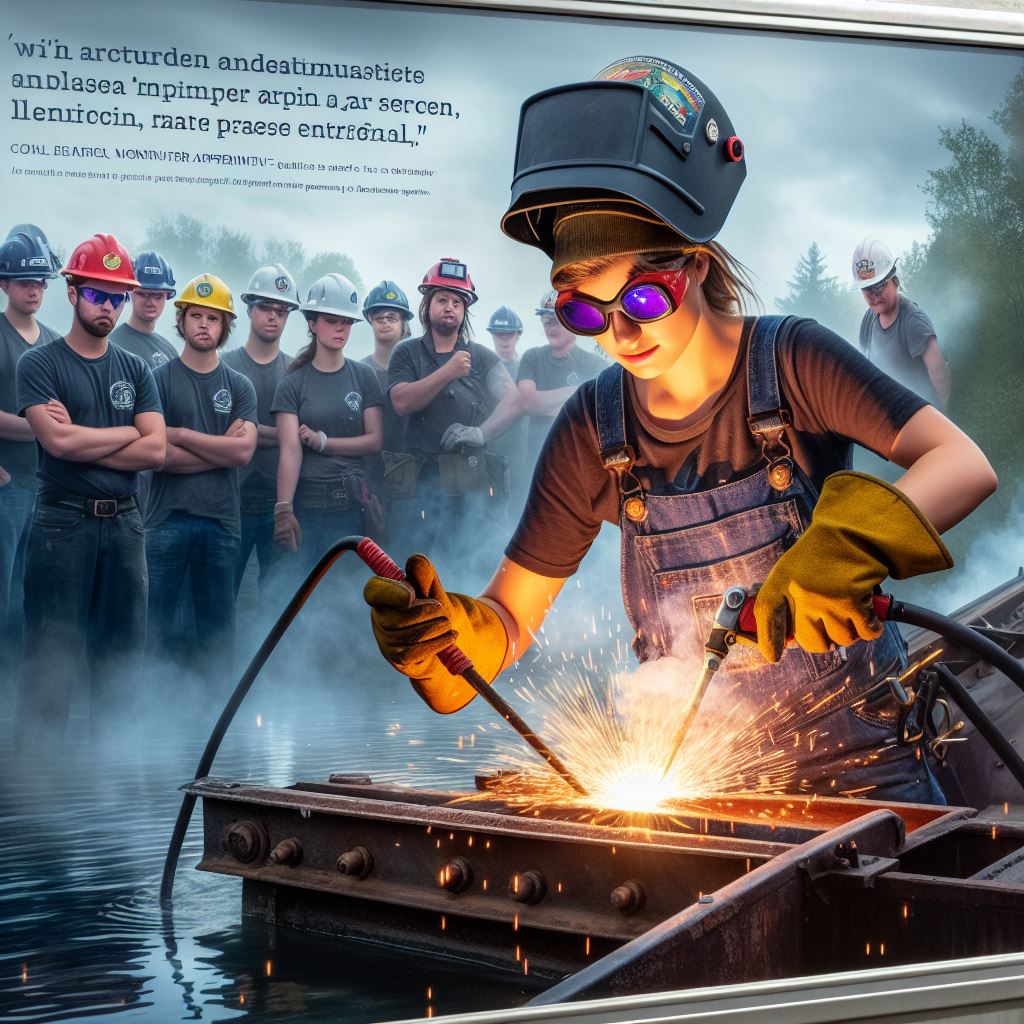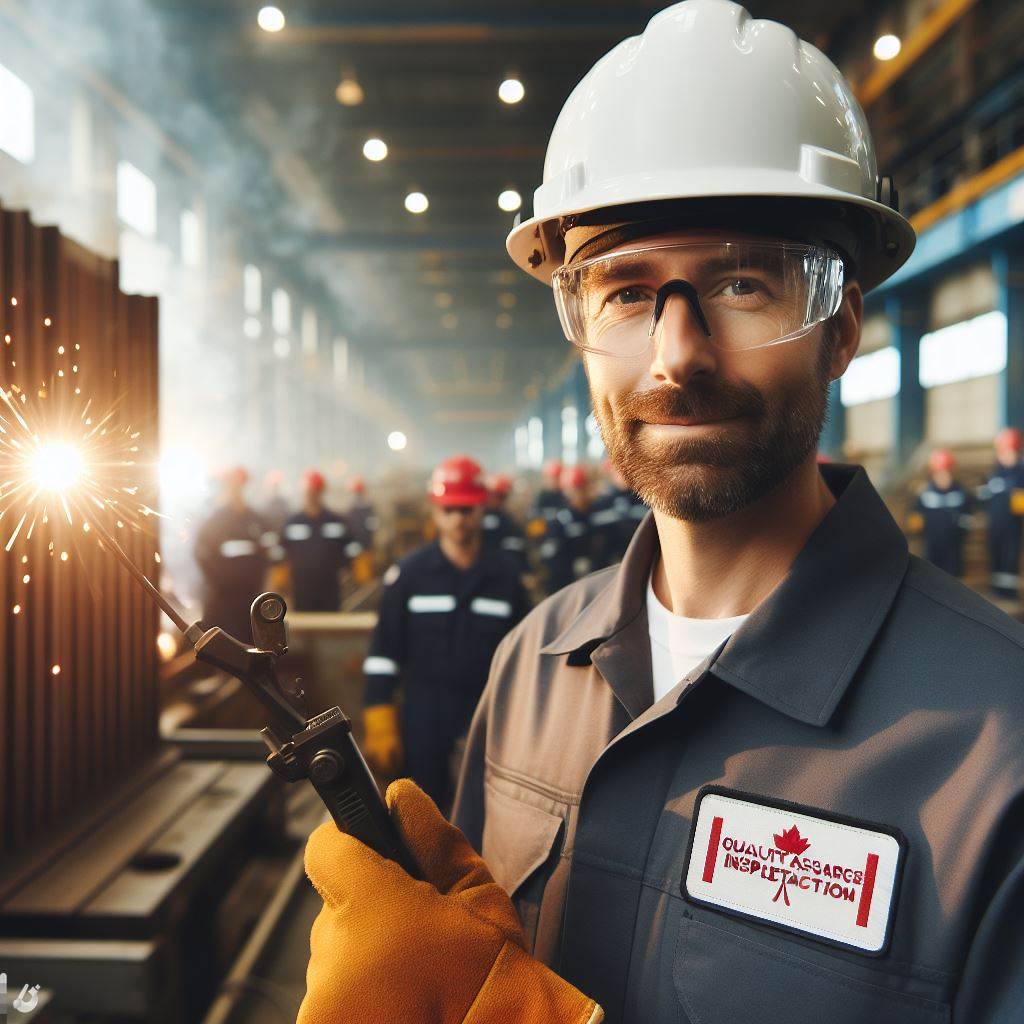Introduction
Welding plays a crucial role in construction and manufacturing industries in Canada.
It involves joining materials like metals through the application of heat and pressure.
However, the environmental impact of welding cannot be overlooked.
It is essential to study and address this issue to mitigate the negative effects on the environment and human health.
Studying and addressing the environmental impact of welding in Canada is important for several reasons.
First, welding processes release hazardous gases, such as ozone and nitrogen oxide, which contribute to air pollution.
This pollution can lead to respiratory problems and other health issues.
Second, welding generates metal fumes and dust particles that have detrimental effects on air quality.
These particles, when inhaled, can cause lung diseases and increase the risk of lung cancer.
Additionally, heavy metal contaminants released during welding can contaminate soil and water sources, posing risks to ecosystems and potentially entering the food chain.
Third, the energy consumption associated with welding contributes to carbon emissions and the depletion of natural resources.
By studying and addressing the environmental impact, we can identify and implement measures to reduce energy consumption, promote cleaner technologies, and minimize carbon footprints.
Moreover, addressing the environmental impact of welding is crucial for sustainable development.
By adopting greener practices, such as using recycled materials and implementing efficient ventilation systems, we can mitigate the environmental harm caused by welding activities.
In short, understanding and addressing the environmental impact of welding in Canada is essential to safeguard the environment, protect human health, and promote sustainable development.
By implementing proper regulations, adopting advanced technologies, and raising awareness, we can minimize the negative effects of welding on the environment and create a more sustainable future.
Overview of welding process in Canada
Welding is a crucial process used extensively in various industries across Canada.
It involves uniting two or more pieces of metal by melting and fusing them together, creating a strong joint.
By employing different welding techniques, skilled welders contribute to the construction, manufacturing, and maintenance of numerous structures.
- Welding involves melting and fusing pieces of metal to create a strong joint.
- Skilled welders contribute to construction, manufacturing, and maintenance of structures.
- Various welding techniques are employed depending on the requirements and metal types.
- Welding is vital for the growth and sustainability of the Canadian economy.
General Explanation of Welding and its Applications in Canada
- Welding is the process of joining metal pieces together through fusion.
- It finds applications in industries such as automotive, construction, aerospace, and shipbuilding.
- Welding is essential for fabricating metal structures, pipelines, and equipment.
- It plays a crucial role in manufacturing machinery, vehicles, and various consumer products.
Common Types of Welding Techniques Used in Canada
- Shielded Metal Arc Welding (SMAW): A manual process utilizing a consumable electrode.
- Gas Metal Arc Welding (GMAW): Uses a continuous wire electrode and shielding gas.
- Gas Tungsten Arc Welding (GTAW): Employs a non-consumable tungsten electrode and inert gas.
- Flux-Cored Arc Welding (FCAW): Utilizes a tubular wire electrode with flux inside.
- Submerged Arc Welding (SAW): Involves submerging the electrode and arc in a layer of flux.
Significance of Welding in Various Industries
- Construction Industry: Welding is vital for building infrastructure, bridges, and skyscrapers.
- Automotive Industry: Welding ensures the production of reliable and safe vehicles.
- Aerospace and Defense Industry: Welding contributes to the fabrication of aircraft and military equipment.
- Manufacturing Industry: Welding is integral for producing machinery and other industrial equipment.
- Oil and Gas Industry: Welding ensures the construction and maintenance of pipelines and refineries.
- Shipbuilding Industry: Welding is essential for constructing ships and offshore structures.
In fact, welding is a crucial component of the Canadian economy, playing an essential role in various industries.
By uniting metal pieces and structures, welding enhances the strength, reliability, and safety of numerous products and infrastructures.
Skilled welders using different techniques contribute significantly to the growth and development of Canada’s construction, manufacturing, and maintenance sectors.
Read: Safety Standards in Canada’s Construction
Environmental concerns related to welding
Welding is a widely used industrial process that joins materials together by melting them. However, it also poses significant environmental concerns.
The emission of hazardous gases and fumes during welding
One of the major issues associated with welding is the emission of hazardous gases and fumes.
Unlock Your Career Potential
Visualize a clear path to success with our tailored Career Consulting service. Personalized insights in just 1-3 days.
Get StartedThese emissions include gases such as ozone, nitrous oxides, and volatile organic compounds (VOCs), as well as metal fumes.
The potential harm caused by these emissions to the environment
The potential harm caused by these emissions to the environment is considerable. Ozone is a greenhouse gas that contributes to climate change.
Nitrous oxides are a major contributor to air pollution, leading to smog and respiratory problems.
VOCs can also contribute to air pollution and can have harmful effects on human health.
The metal fumes produced during welding contain toxic elements such as manganese, chromium, and nickel.
These fumes can contaminate the air and soil, posing a risk to both humans and wildlife.
Long-term exposure to these substances can lead to serious health conditions, including respiratory diseases and cancer.
Statistics or studies on the environmental impact of welding in Canada
Several studies and statistics highlight the environmental impact of welding in Canada.
According to the Ontario Ministry of Environment and Climate Change, the metal fabrication and welding sector is one of the significant contributors to air emissions in the province.
These emissions include nitrogen oxides and fine particulate matter.
A study conducted by the University of British Columbia analyzed the environmental impact of welding in the construction industry.
The research showed that welding contributes to carbon dioxide emissions, mainly through the electricity consumption during the welding process.
The study also emphasized the importance of adopting more sustainable welding practices to reduce the environmental footprint.
Another study published in the Journal of Cleaner Production evaluated the environmental impact of different welding technologies in Canada.
The study compared traditional arc welding techniques with advanced processes, such as laser and electron beam welding.
It concluded that advanced welding technologies have the potential to significantly reduce greenhouse gas emissions and energy consumption.
Addressing the environmental impact of welding requires a multi-faceted approach.
Implementing effective ventilation systems and utilizing appropriate personal protective equipment can minimize the release of hazardous gases and fumes into the environment.
Moreover, promoting the use of advanced welding technologies can further reduce emissions and energy consumption.
In essence, the environmental concerns related to welding in Canada are significant.
The emission of hazardous gases and fumes during welding poses a potential risk to the environment.
Statistics and studies highlight the environmental impact of welding, emphasizing the need for sustainable practices and technology advancements in the industry.
Read: Electrician Salary Ranges in Canada’s Provinces
Air Pollution Control Measures
When it comes to the environmental impact of welding in Canada, one of the major concerns is air pollution.
Welding processes release various emissions into the atmosphere, including hazardous pollutants and greenhouse gases.
In order to mitigate these harmful effects, several air pollution control measures have been put in place.
Exploring Regulations and Guidelines
The Canadian government has established regulations and guidelines specifically targeting welding emissions.
These regulations outline the permissible emission levels for various pollutants and set standards that welding operations must comply with.
By exploring these regulations, it becomes evident how seriously the Canadian government takes air pollution control.
The Role of Canadian Government Agencies
In order to enforce environmental standards and ensure compliance with regulations, Canadian governmental agencies play a crucial role.
These agencies, such as Environment Canada and provincial environmental ministries, monitor welding operations and conduct regular inspections to verify compliance.
They also have the authority to issue fines and penalties for non-compliance, motivating welding companies to adhere to environmental standards.
Initiatives by Welding Industry Organizations
In addition to government regulations, welding industry organizations have taken proactive measures to mitigate the environmental impact of welding.
These organizations recognize the need to operate in an eco-friendly manner and actively promote sustainable practices among their members.
They provide resources, training, and support to help companies adopt cleaner and more efficient welding techniques.
One such initiative is the development and promotion of green welding technologies.
These technologies focus on reducing emissions and minimizing energy consumption during the welding process.
By using advanced equipment and techniques, such as high-efficiency power sources and optimized shielding gases, companies can significantly lower their environmental footprint.
Welding industry organizations also encourage the proper management of welding by-products and waste.
They emphasize the importance of recycling and responsible disposal of welding materials, such as metal shavings, used consumables, and slag.
By implementing effective waste management practices, the industry aims to minimize the release of harmful substances into the environment.
Furthermore, these organizations actively engage in research and development of innovative solutions to further reduce the environmental impact of welding.
They collaborate with government agencies, academic institutions, and other stakeholders to identify and implement cutting-edge technologies and best practices.
Through these collective efforts, the industry strives for continuous improvement and sustainability.
In general, the environmental impact of welding in Canada necessitates effective air pollution control measures.
This includes exploring and adhering to government regulations, understanding the role of Canadian governmental agencies, and actively participating in industry initiatives.
By adopting cleaner technologies, managing waste responsibly, and promoting sustainable practices, the welding industry can mitigate its impact and contribute to a greener future.
Read: Electrician Certifications in Canada: A Guide

Advancements in welding technology
Recent developments in welding techniques and equipment
Recent developments in welding techniques and equipment have made significant strides in minimizing environmental impact.
These advancements have led to the implementation of various eco-friendly welding technologies in Canada.
Examples of eco-friendly welding technologies implemented in Canada
Laser Beam Welding
Laser beam welding is a highly efficient process that utilizes a focused laser beam to join materials.
It minimizes the environmental impact by reducing energy consumption and minimizing waste generation.
This technique is widely used in the aerospace industry, where precision and clean welds are crucial.
Friction Stir Welding
Friction stir welding is a solid-state joining process that produces high-quality and defect-free welds.
It reduces the environmental impact by eliminating the need for filler material, reducing energy consumption, and minimizing the emission of hazardous fumes.
It finds applications in the automotive and shipbuilding industries.
Plasma Arc Welding
Plasma arc welding utilizes a highly ionized gas to generate an electric arc for welding.
It offers improved energy efficiency compared to traditional welding techniques like shielded metal arc welding.
The precise control and concentrated heat input minimize the environmental impact and enhance the quality of welds.
Green Welding
Green welding involves the use of environmentally friendly materials and processes to minimize the overall ecological footprint.
This includes using recycled consumables, implementing advanced filtration systems, and employing energy-efficient welding equipment.
Green welding practices aim to reduce waste generation, conserve resources, and minimize pollution.
Advanced Welding Equipment
The development of advanced welding equipment has contributed significantly to reducing the environmental impact of welding in Canada.
New technologies, such as advanced power sources and digital controls, enable precise control of the welding process, resulting in minimal material waste and energy consumption.
Robotic Welding Systems
Robotic welding systems have revolutionized the welding industry by increasing productivity, accuracy, and efficiency.
These systems can be programmed to optimize welding parameters, leading to reduced material waste and improved weld quality.
Robotic welding also reduces the exposure of human welders to hazardous fumes and improves workplace safety.
Training and Certification Programs
The implementation of training and certification programs for welders ensures the adoption of eco-friendly welding techniques.
These programs focus on educating welders about the latest advancements in welding technology and teaching them environmentally conscious practices.
Proper training results in improved welding skills and promotes sustainable welding practices.
The advancements in welding technology have had a tremendous positive impact on minimizing the environmental footprint of welding in Canada.
Through the implementation of eco-friendly welding technologies and the adoption of sustainable practices, the welding industry can contribute to a cleaner and greener future.
Read: A Day in the Life of a Canadian Electrician
Best Practices for Environmentally Responsible Welding
Welding plays a vital role in various industries, but it also has a significant impact on the environment.
In Canada, efforts are being made to reduce the environmental footprint of welding practices.
Guidelines and practices that welders can follow to reduce their environmental footprint
Here are some best practices that welders can follow to contribute to a greener future:
Use Energy-Efficient Equipment
- Invest in energy-efficient welding machines and accessories to minimize energy consumption.
- Opt for equipment with power management features that reduce idling and standby energy use.
- Regularly maintain and calibrate equipment to ensure optimal performance and energy efficiency.
Reduce Harmful Emissions
- Limit the release of harmful fumes and gases by using low-emission welding processes.
- Implement proper ventilation systems to quickly remove welding fumes from the work area
- Opt for gas shielding instead of flux-cored welding to mitigate the emission of hazardous substances.
Practice Material Efficiency
- Minimize material wastage by accurately planning and measuring the required amounts for each welding job.
- Encourage the use of recycled or reclaimed metals whenever possible to reduce the extraction of new resources.
- Implement proper storage and handling techniques to prevent material damage or contamination.
Optimize Welding Processes
- Choose welding techniques that require lower energy consumption and produce less waste.
- Consider using automation and robotics to improve precision and reduce errors, thereby minimizing rework and material waste.
- Train welders to optimize welding parameters, such as voltage, current, and wire feed speed, to maximize efficiency and reduce waste.
Importance of Proper Training and Certification
Proper training and certification are crucial for welders to understand the environmental impact of their work and adopt sustainable practices.
When welders undergo formal training and certification, they gain valuable knowledge about:
- Proper handling and disposal of hazardous materials.
- Understanding and interpreting welding codes and standards.
- Identifying potential environmental risks and implementing preventive measures.
- Updating skills and techniques to stay up-to-date with eco-friendly welding practices.
Tips and Recommendations for Sustainability in Welding Practices
- Regularly participate in workshops, seminars, and conferences to stay informed about advancements in environmentally friendly welding.
- Collaborate with other professionals and organizations to share best practices and learn from their experiences.
- Educate clients and customers about the benefits of opting for sustainable welding practices.
- Implement a waste management plan that includes proper disposal, recycling, and reuse of welding by-products.
- Monitor energy consumption and keep track of improvements to assess the effectiveness of adopted measures.
By following these best practices and promoting environmentally responsible welding techniques, welders in Canada can significantly reduce their environmental footprint and contribute to a more sustainable future.
Conclusion
The environmental impact of welding in Canada cannot be ignored. We have seen that the process releases harmful emissions and produces hazardous waste.
It is essential for us to address this issue and take necessary steps to mitigate its effects on the environment.
The main points discussed in this blog post include the emissions released during the welding process, the hazardous waste generated, and the potential health risks associated with welding.
These factors contribute to the overall negative impact on the environment.
It is crucial to emphasize the importance of addressing the environmental impact of welding in Canada.
By taking proactive measures, we can reduce pollution, conserve resources, and protect human health.
This issue should be a priority for individuals, businesses, and the government.
To promote eco-friendly welding practices, we urge readers to support and adopt sustainable techniques.
This includes using low-emission equipment, implementing proper waste management protocols, and investing in training programs for welders.
Small steps can make a significant difference in minimizing the environmental footprint of welding.
By embracing eco-friendly welding practices, we not only protect the environment but also create a healthier and more sustainable future for ourselves and future generations.
Let us work together to make a positive impact and preserve the beauty of our environment.




